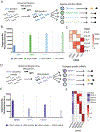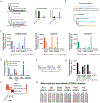Field-deployable viral diagnostics using CRISPR-Cas13
- PMID: 29700266
- PMCID: PMC6197056
- DOI: 10.1126/science.aas8836
Field-deployable viral diagnostics using CRISPR-Cas13
Abstract
Mitigating global infectious disease requires diagnostic tools that are sensitive, specific, and rapidly field deployable. In this study, we demonstrate that the Cas13-based SHERLOCK (specific high-sensitivity enzymatic reporter unlocking) platform can detect Zika virus (ZIKV) and dengue virus (DENV) in patient samples at concentrations as low as 1 copy per microliter. We developed HUDSON (heating unextracted diagnostic samples to obliterate nucleases), a protocol that pairs with SHERLOCK for viral detection directly from bodily fluids, enabling instrument-free DENV detection directly from patient samples in <2 hours. We further demonstrate that SHERLOCK can distinguish the four DENV serotypes, as well as region-specific strains of ZIKV from the 2015-2016 pandemic. Finally, we report the rapid (<1 week) design and testing of instrument-free assays to detect clinically relevant viral single-nucleotide polymorphisms.
Copyright © 2018 The Authors, some rights reserved; exclusive licensee American Association for the Advancement of Science. No claim to original U.S. Government Works.
Conflict of interest statement
Figures




Comment in
-
Next-generation diagnostics with CRISPR.Science. 2018 Apr 27;360(6387):381-382. doi: 10.1126/science.aat4982. Science. 2018. PMID: 29700254 No abstract available.
-
From CRISPR scissors to virus sensors.Nature. 2018 May;557(7704):168-169. doi: 10.1038/d41586-018-04975-8. Nature. 2018. PMID: 29730672 No abstract available.
-
CRISPR-based diagnostics.Nat Med. 2018 Jun;24(6):702. doi: 10.1038/s41591-018-0073-z. Nat Med. 2018. PMID: 29875459 No abstract available.
-
Cutting-Edge Infectious Disease Diagnostics with CRISPR.Cell Host Microbe. 2018 Jun 13;23(6):702-704. doi: 10.1016/j.chom.2018.05.016. Cell Host Microbe. 2018. PMID: 29902435 Free PMC article.
References
-
- Faye O et al., One-step RT-PCR for detection of Zika virus. J. Clin. Virol 43, 96–101 (2008). - PubMed
Publication types
MeSH terms
Substances
Grants and funding
LinkOut - more resources
Full Text Sources
Other Literature Sources
Medical

